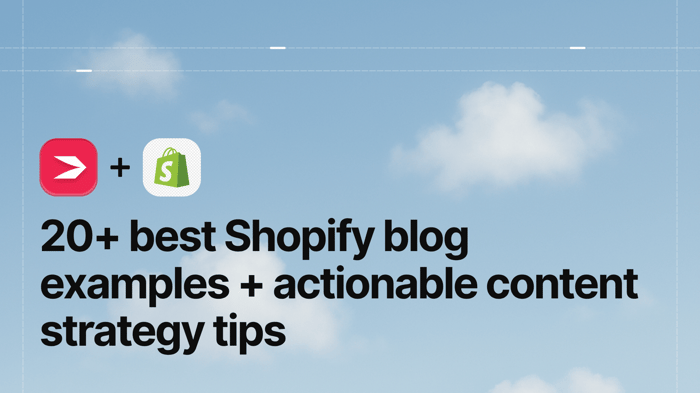Today, blogging has evolved into a sophisticated marketing tool many businesses use to increase visitor-to-customer conversion, drive traffic to their site, and earn more money.
As most marketers are aware, Shopify is one of the best platforms for blogging, and it fits perfectly with DropInBlog – the SEO-friendly blogging tool. That’s why in today’s article, we’ll talk about the best Shopify blog examples to inform and inspire your blogging efforts, and we’ll share a step-by-step guide to creating an effective content marketing strategy. Let’s begin!
Table of Contents
- 20+ Best Shopify Blog Examples + How to Copy Their Strategy
- Step-by-Step Guide to Take Your Content Marketing Strategy Game to the Next Level
- FAQs on Running a Shopify Blog
- How do I start a Shopify blog?
- Is blogging on Shopify good for SEO?
- How can you monetize a Shopify blog?
- Do blog posts work on Shopify stores?
- Which Shopify theme is best for blogging?
- How do blogs work on Shopify?
- Can I put recent blog posts on my Shopify homepage?
- Does it cost money to start a blog?
- Is Shopify a good place to start a blog?
- Over and Out
20+ Best Shopify Blog Examples + How to Copy Their Strategy
All businesses that run blogs use their blogging platforms in their own unique ways. We picked 22 Shopify blogs with diverse content and marketing strategies and took some key takeaways from each. Let’s check them out.
The Lost Recordings
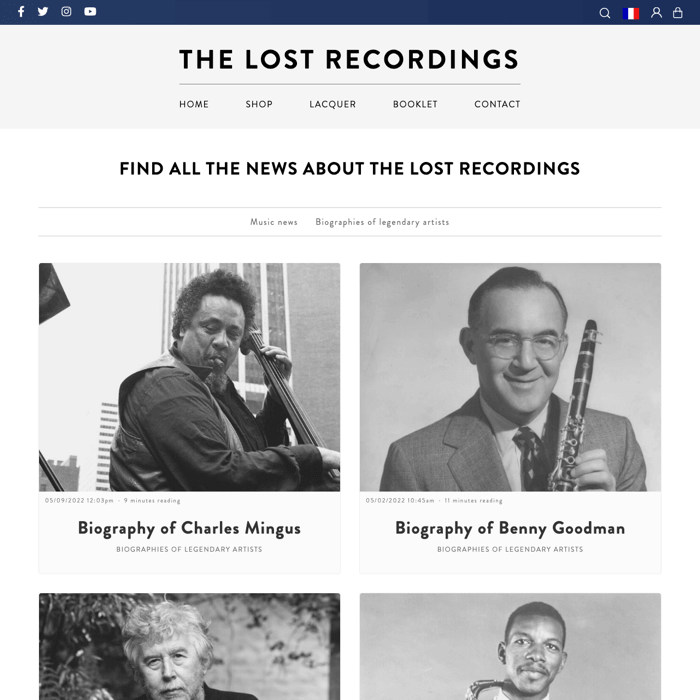
Our Favorite Post: The History of Jazz
The Lost Recordings is a record company that finds and restores rare or previously unreleased recordings from renowned artists and sells them in their online shop as vinyl records, CDs, and HD downloads.
Their blog is a perfect example of a niche blog done right. The blog posts are either biographies of iconic musicians, mostly from the jazz scene, like Miles Davis and Billie Holiday, or music news about festivals or what musicians are up to. Some of their posts, usually those about the artists whose recordings they’ve released, briefly mention their products, but this is not obnoxious – it helps the reader know which particular record they can find in the shop.
The design of the blog (and the website overall) is very evocative of 20th-century media. There’s an almost newspaper-like quality to it simply because they exclusively use black and white photos of the artists. The blog post previews are large, with the images dominating the thumbnails. Overall, the blog has a very classic feel, perfect for music aficionados and record collectors.
Key Takeaway: Many brands and companies try to diversify their blog content to attract as many visitors as they can, but for niche businesses, sticking to the niche may be the better option.
Schăf Skincare
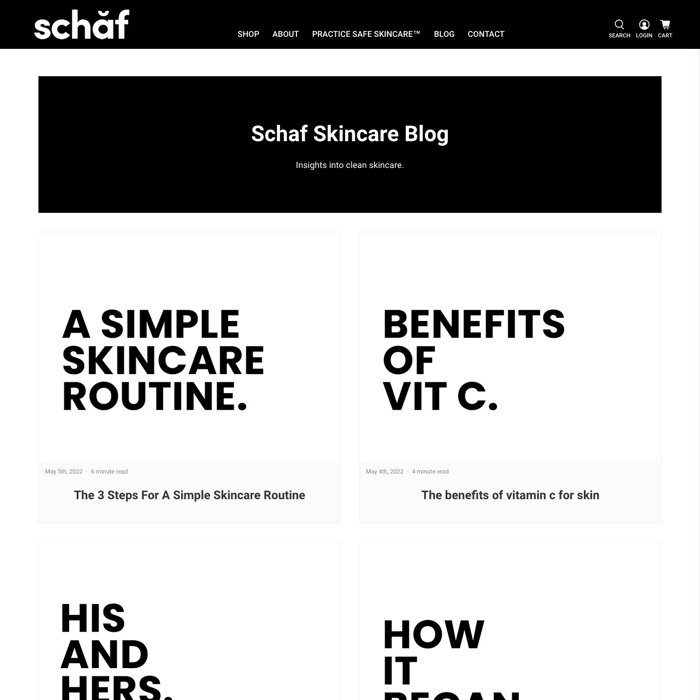
Our Favorite Post: How to Achieve Healthy Skin
Skincare has always been a popular topic, but in the last few years, its popularity has grown exponentially as many new brands have emerged on the market. So, it should go without saying that for skincare brands, having a blog is imperative for increasing engagement and driving traffic.
In this respect, the benefits that Schăf get from their blog are three-fold: they use it as a space to write engaging and relevant content while promoting their brand and giving helpful instructions on how to use their products. On their blog, you’ll find advice and informative articles that feature their products, as well as articles about their journey as a brand and how it all began.
Schăf’s brand philosophy is “less is better,” and this is strongly reflected in their blog’s design. It’s minimalistic to the maximum (pun intended) and still very eye-catching. The large and imposing black font in all caps works perfectly against the white background, a great example of how seamlessly DropInBlog adapts to the design of this brand’s chosen template, considering that the theme is strictly minimalistic.
Key Takeaway: Visuals are essential when it comes to blogging, so matching the design of your website to your identity as a brand does half the job of communicating your message and complementing your brand voice.
Reperch
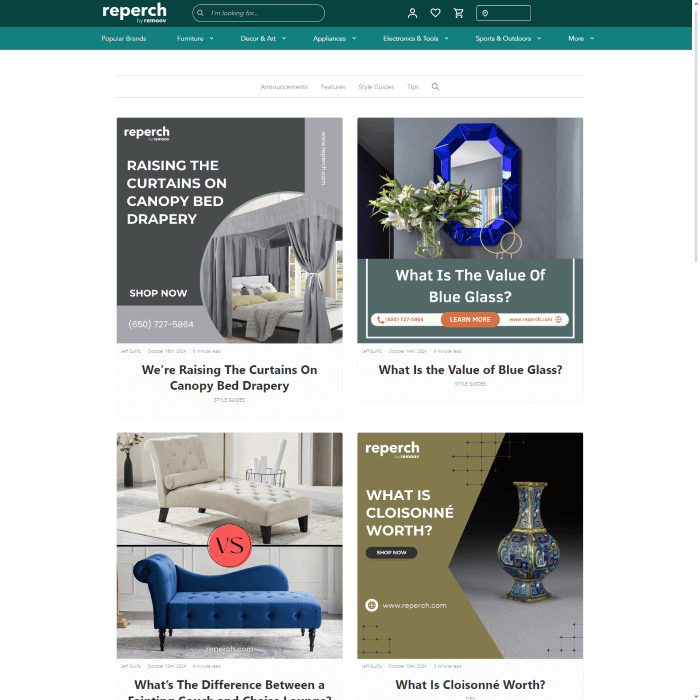
Our Favorite Post: Best Tips for Decorating: Roundup
Reperch is a second-hand goods shop where you can find all sorts of items, like furniture, appliances, electronics, art and collectibles, clothes and accessories, and more. Their blog is a reflection of how professional they are as a brand. It’s regularly updated with relevant content, and has a squeaky clean design.
On their blog, you’ll see a lot of interior design style guides, home decor tips, product roundups, design ideas, and more. Their posts are quite lengthy, but they’re very informative and engaging, and you can tell that the authors are knowledgeable about interior design.
Reperch manages to provide their readers with valuable information and tips that are actionable, rather than fluff, which is not uncommon for brands in this niche that focus on churning out as much content as possible.
What stands out about the Reperch’s content strategy is that you can tell they know about the importance of linking internally to improve site structure and reader experience and lead readers to the product. Nothing seems forced or out of place, as the products are well incorporated into the articles.
Key Takeaway: No matter where you are on your business journey and whether you’ve just started blogging or not, keeping it professional is crucial. It shows in your blog posts, and visitors can certainly see it. Additionally, tailoring your blog content so you can seamlessly incorporate your products into your articles is a great way to subtly promote them.
Rustic Kitchen & Bath
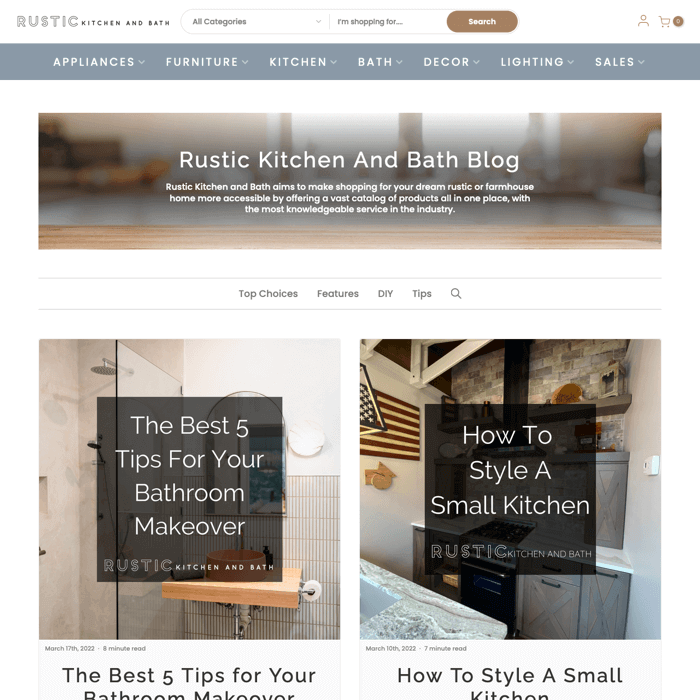
Our Favorite Post: Everything You Need for Your Home Bar
Another one on our best Shopify blog examples list is Rustic Kitchen & Bath, a family-owned household goods store that sells a variety of products – furniture, appliances, decor, and more – with a focus on rustic and farmhouse-style homes. Their blog is interesting because it’s reminiscent of “old-school blogging” – they cover many homeware and interior design topics, and we must say, they do it well.
On their blog, you will find tons of helpful articles, from tips and tricks on decorating a certain room or area in your home, or for a special occasion, to guides and how-to articles. But that’s not all – they also post reviews of home goods manufacturers, some of which they sell in their store.
In addition, each blog post is broken up with many big and beautiful images of interior spaces with credits to the respective image owner, making the posts more visually appealing and easier to follow.
What’s interesting about their blogging is that they rarely include their products in their posts. Their approach to blogging is making purely informational and helpful posts using commonly searched terms and casually adding all of their social media at the bottom of every post.
Key Takeaway: Sticking to traditional blogging by writing informational posts that include commonly searched items is still a great way to attract visitors and customers, even if you don’t actively promote your products in the posts.
All Diamond
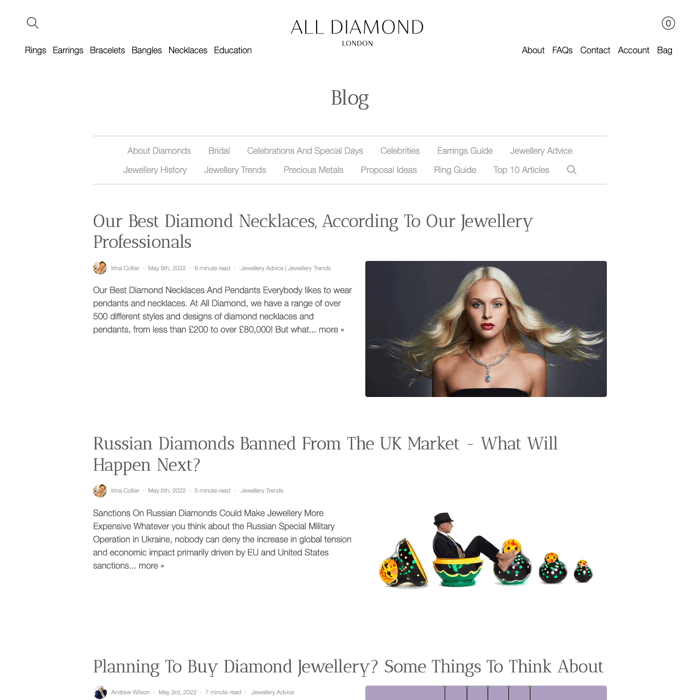
Our Favorite Post: Diamond Cut – The Shape That Makes Your Diamonds Special
Diamond jewelry is often associated with luxury and fashion, so you might think that the majority of the blog posts are related to these topics, but the variety of topics All Diamond covers is astounding. Sure, you have fashion articles, like all the ways you can wear a tennis bracelet, but since buying diamond jewelry is an investment, they also blog about many other helpful topics, like how to recognize fake diamonds and how to insure your diamond jewelry, the history of diamonds, and some tips and tricks on how to take care of them.
All in all, their blog is very well-rounded and focused on providing valuable information to customers and casual readers alike. While they don’t overtly promote their products by talking about them or suggesting them in their blog posts, they do place them like ads in between paragraphs along with an “Add to Cart” button and a short description of the piece.
The best part of the blog is that it gets updated regularly and the posts are well-written and packed with interesting info.
Key Takeaway: It’s really important that you keep your blog alive by posting as regularly as you can so that readers will always have fresh information to digest.
Oddbods

Our Favorite Post: 5 Fun Ideas to Rock Parenthood
Oddbods is a funny and quirky animated non-dialogue children’s show whose philosophy is that diversity and individuality should be celebrated, and that it’s okay to be different from everyone else in your own unique way. The episodes follow seven “oddball” characters through many everyday adventures and misadventures.
So, why would a children’s show require a blog, you ask? Well, the blog is mostly geared toward parents, and Oddbods’ team does this exquisitely. Their blog isn’t there to promote their product as much as to offer valuable information. This is a great way to keep readers engaged.
The content is divided into three categories, Growing, Learning, and Playing. It features helpful and insightful articles for parents, often including parenting advice, informational articles, interviews with family bloggers and experts, as well as simple and fun articles with parenting tips and tricks.
The best part is that they put each of the Oddbods characters as an author to the blog posts and each blog post preview has a customized image with the characters that fits the article's topic. This makes their branding on point, but also lends some fun to their blog design and makes it cohesive. The design itself is relatively plain, but this is a good thing in this case because it lets the colorful images of the Oddbods stand out.
Key Takeaway: If you think your particular business has no business running a blog, think again. Blogging is very versatile, and when done right, it can work for any type of business, even when your brand is about something seemingly difficult to blog about.
Selkie
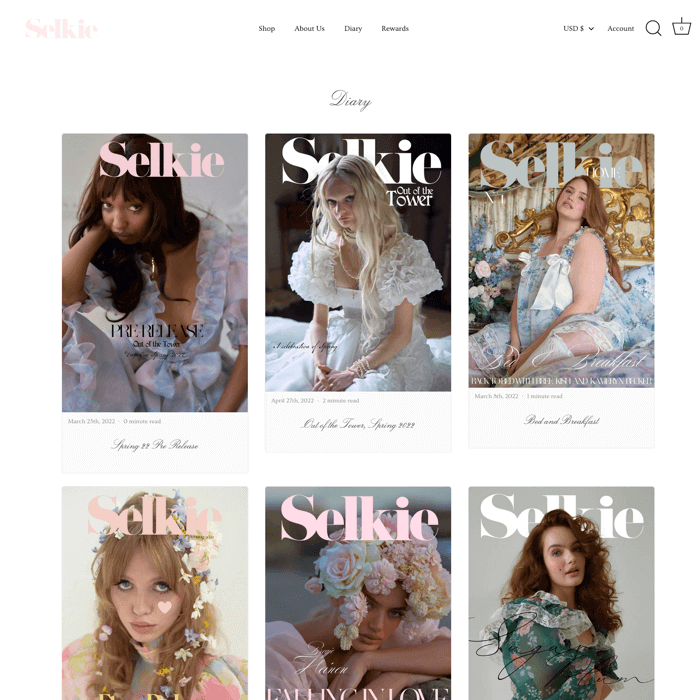
Our Favorite Post: Electric Ladies
Selkie is a size-inclusive, low-waste clothing company that manufactures different styles of dresses inspired by Irish, Scottish, Icelandic, and Scandinavian folklore. Their blog design perfectly matches the signature style of their dresses – feminine, light, and delicate. You’re greeted by a pale pink background that gives way to the blog post previews, which look much like magazine covers.
We must say, this goes well with their aesthetic as it’s certainly memorable. The blog posts themselves read part like magazine ads, part like diary entries, and part like customers’ testimonials – that is, if there’s anything written at all, as some posts consist of photos only, with editorial quality.
Sometimes, it’s a combination of the two, as Selkie isn’t bound by conventions or limits. Some blog posts are like scrapbooks and mood boards, with the intention to not only bring attention to the dresses in the photos but to also create a vivid representation of the world of Selkie.
It’s safe to say that Selkie’s blog wasn’t intended to attract just passing readers but to convert interested visitors – who are already aware of the brand – into returning customers.
Key Takeaway: Don’t be afraid to play with the style of your blog posts. Sticking to the classic approach of incorporating good SEO practices is great, but if the nature of your niche and the philosophy of your brand allows it, you can certainly color outside the lines.
Upcycle Hawaii
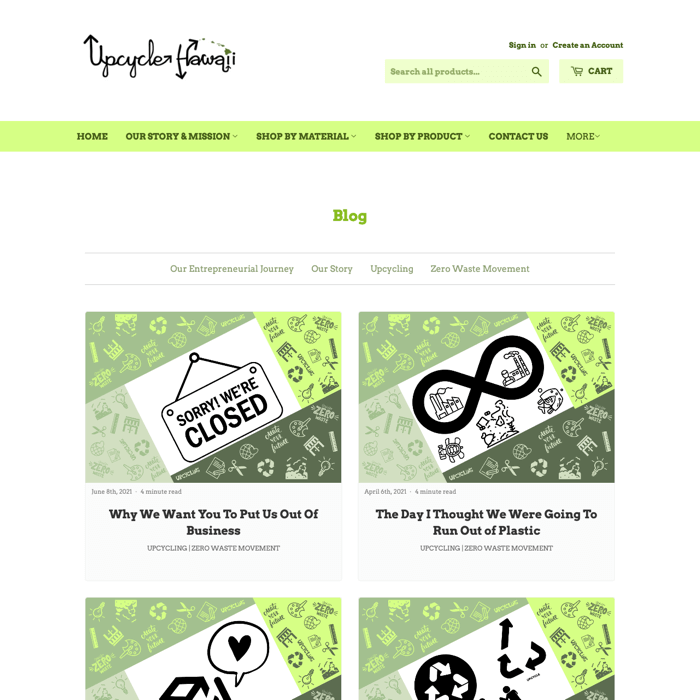
Our Favorite Post: Beauty Is in the Eye of the Beholder
In today’s world, it’s not easy to fight against pollution, but there are still many activists who do just that, and some of them do it in very creative ways. Meet Upcycle Hawaii, an upcycling studio that turns plastic and marine debris into fashionable and usable items, like tote bags, wallets, earrings, ornaments, stickers, and more. In their own words, they turn “trash to treasure.”
As a successful member of the green movement, Upcycle Hawaii’s Shopify blog is also a pleasant shade of green. The design is simple and to the point, so that your eye is drawn toward the blog post previews, which feature original green-themed illustrations in the same style that match the topics of the articles.
Upcycle Hawaii’s website is a personal labor of love; their blog posts often feature personal details from the founders. They use their blogging platform to establish a relationship with like-minded people and educate individuals new to the green movement. Their blog posts are often personal musings, but they also blog about what’s new with their business and post educational articles about the zero-waste movement, like the difference between recycling and upcycling.
Key Takeaway: Don’t be afraid to get a little personal in your blog posts if that’s something you think fits your brand, because it helps strengthen the relationship with your readers.
Nori
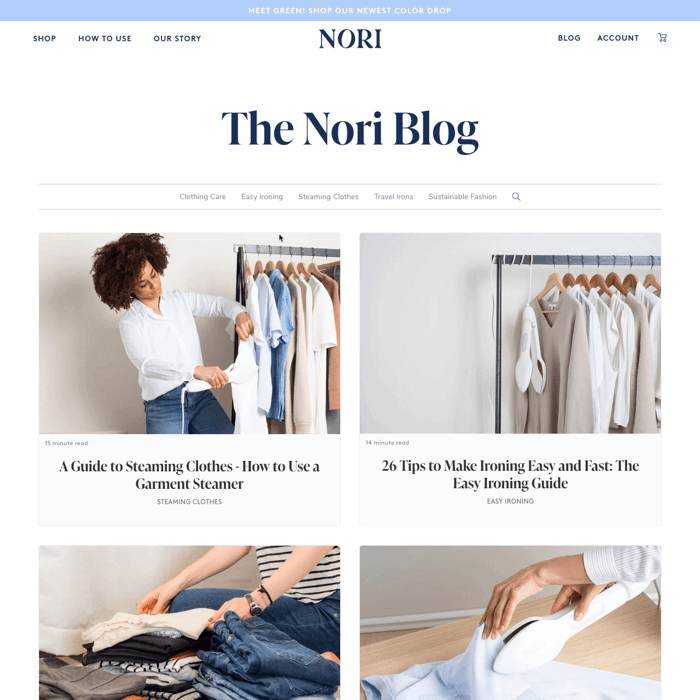
Our Favorite Post: How to Take Care of Your Clothes: The Ultimate Guide to Clothing Care
How often have you skipped ironing because you felt lazy or simply procrastinated with this task for days on end? Nori, which is just iron spelled backward, is a clothing care brand that aims to “change the existing perception of ironing,” and their approach to blogging has put them on our list of the best Shopify blog examples.
You may wonder what an ironing brand could have to blog about. It’s simple – besides blog posts about clothing care and ironing tips, Nori expands their interests to sustainable fashion. Their blog features five different categories: Clothing Care, Easy Ironing, Steaming Clothes, Travel Irons, and Sustainable Fashion. In each of these, you can find many informative tips, advice, how-to articles, sustainable fashion recommendations, and more, and each article is very articulate and helpful.
Nori’s publishing team include original photographs in each of their blog posts, which adds to the professional look of the blog. The design itself is very clean and fresh, with a white background and light blue and indigo accents, very reminiscent of crisp and fresh laundry ready to be pressed with their signature product, the Nori Press.
Key Takeaway: We can learn a lot from Nori, but most importantly, that the more topics you blog about and the more diverse articles you write, the bigger the chances for your blog to perform well.
YankeeKicks
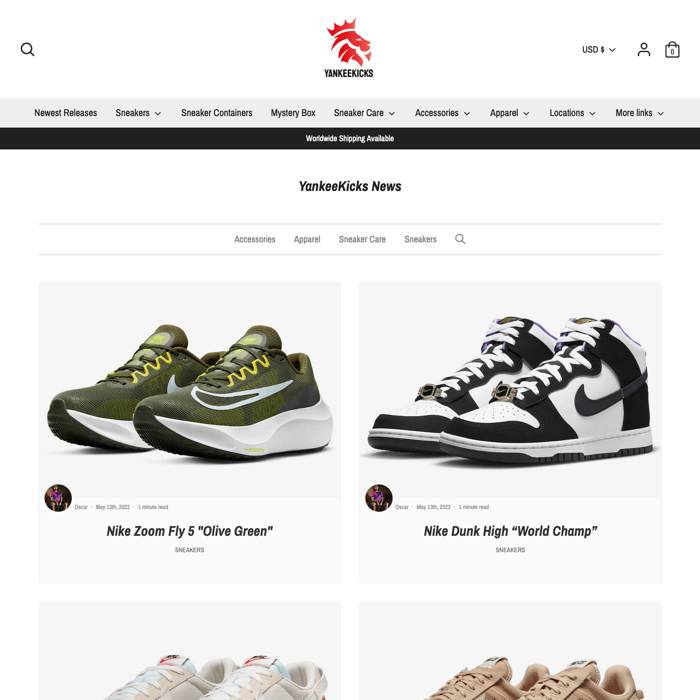
Our Favorite Post: Protect What Matters: Your Sneakers
Sometimes, you don’t need your blog to be anything other than a place where you can put a very nice high-res image of your product, write a short description, and leave it be. After all, the product speaks for itself and you know it’s the information most visitors or customers are looking for. YankeeKicks, the premium sneaker and apparel store, does this perfectly and that’s why their blog is on our list of the best Shopify blog examples.
YankeeKicks sell a lot, and I mean, a lot of products. Their inventory is every sneaker lover’s dream, so it’s no wonder that the purpose of their blog is to organize these items somehow so that visitors can easily find exactly what they’re looking for. Their blog consists of four different categories based on the types of products: Accessories, Apparel, Sneaker Care, and Sneakers.
Having said that, you may wonder about the difference between these blog posts and the actual product pages. The difference is obvious – the product pages are too busy with user reviews, sizing charts, and recommended products for any sort of dedicated description to fit there, while the blog posts are where you get informed about products and their characteristics. In other words, it’s good marketing.
Key Takeaway: Turning your blog into a sort of “catalog exploration” may be an excellent idea if you have a lot of different products. And even if you don’t, it’s a good way to draw attention to a product and present it to your readers.
Hoff and Pepper

Our Favorite Post: Hey Hoff & Pepper! Why Not Ferment?
Hoff and Pepper is a hot sauce brand that produces a variety of sauces and seasonings to go with various meals. It’s a brand that started out spontaneously after the founders started gifting homemade sauces to family and friends and got rave reviews. This communal spirit translates into their blog as well.
Their blog posts are written in an informal and friendly tone, as if you’re reading the personal blog of a friend. Most blog posts are about their products and what’s new with their business, but they also write recommendations and recipes featuring their sauces. Since they also have a YouTube channel, they include videos in some articles as supplementary information.
The friendly atmosphere is part of the brand, so by having an informal approach, Hoff and Pepper use their blogging platform to build lasting relationships with customers.
Key Takeaway: If your main goal is to get closer to your customers, you can forgo all formalities and write casual blog posts where you’ll still include your products as part of the content.
YourStuffMade
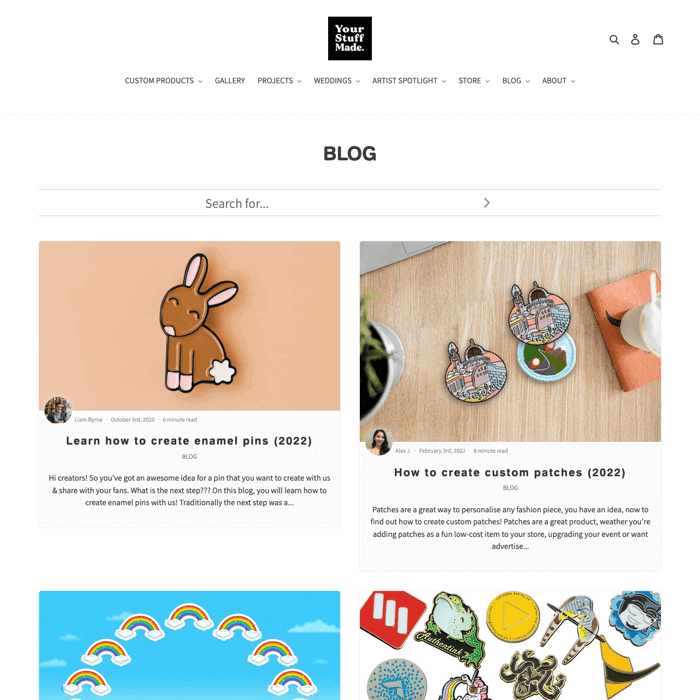
Our Favorite Post: What Is Product Development? Learn The 7-Step Process
We live in an era where there’s a growing emphasis on ethical manufacturing and sustainability, and one good example of such a business is YourStuffMade, an artist-owned product manufacturer and sourcing agency. Their team consists of creators located in several places worldwide who manufacture custom products, with enamel pins being the most popular.
Their blog is on our list of best Shopify blog examples because of its content. Having a diverse team of visual artists, YourStuffMade use their blogging platform to give voice to other talented artists, visual and musical artists alike, and provide them with a space to showcase their work and talk about themselves. Therefore, many of their blog posts are artist features where they have the artists say a word of advice for their peers.
Apart from these articles, YourStuffMade expands into many other topics closely related to their brand philosophy – ethical production, how to start selling online, and even how to create DIY enamel pins and stickers.
Key Takeaway: Don’t be afraid to use your blogging platform to express yourself and your business philosophy. You never know, you might end up making some great connections once you put your thoughts out there.
SpyGuy
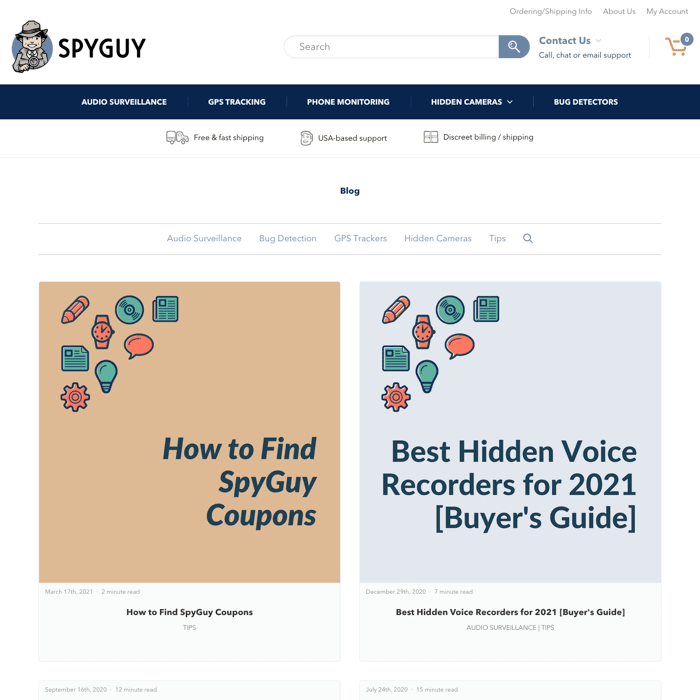
Our Favorite Post: Airbnb Hidden Cameras: Here's How to Find Them
SpyGuy is a curated spy equipment online store whose logo of a smiling inspector dressed in a beige trenchcoat and a hat conjures up images of the private investigators you see in old-school black and white movies. Pretty badass, but their blog posts aren’t that dramatic.
Instead, the team over at SpyGuy uses their blogging platform to educate people about the types of spy equipment, how to use it, and the laws surrounding it. Since surveillance can be a tricky topic to discuss, they make sure to keep a neutral and ethical stance and remain objective when talking about sensitive topics, like whether using personal surveillance is ethical. Other types of articles they blog about include product recommendations, reviews, and guides.
SpyGuy use a lot of internal linking for their SEO strategy, which is only logical considering that their blog is regularly updated and they already have a lot of content. But the titles of their articles are also very much created to arouse your curiosity, so if you ever find yourself on their blog, you’ll likely want to read more than one article.
Key Takeaway: Your tone of voice is very important when blogging about sensitive topics, so the more neutral and objective you can be, the better. Also, using some attention-grabbing titles is a great way to increase clicks and engagement.
Tateossian

Our Favorite Post: All About Precious Gemstones
Tateossian is a well-known UK jewelry and accessories brand whose engaging blog posts have put them on our list of the best Shopify blogs. They use their blogging platform to primarily showcase their products and product collections, but occasionally, they publish gift and style guides and share news about the brand.
What’s so interesting about their posts is the way they’re written. Even though you’ll see them talking about their products in every post, it certainly doesn’t sound salesy or pushy. Instead, their posts read almost like articles in a fashion and lifestyle magazine.
Through their posts, you’ll learn facts about how one of the most popular flower festivals in the UK started, what talismans are, all about pearls, and bits and pieces about Greek mythology. Simply put, they take an idea connected to a certain piece of jewelry or a collection and build upon it from different angles until they have super-intriguing content.
Key Takeaway: How you write your blog posts matters and posts that are well written can make a big difference. However engaging the topic itself may be, if you don’t make an effort to elevate it, it won’t be memorable and stand out from the rest.
Petra Gut Contemporary AG
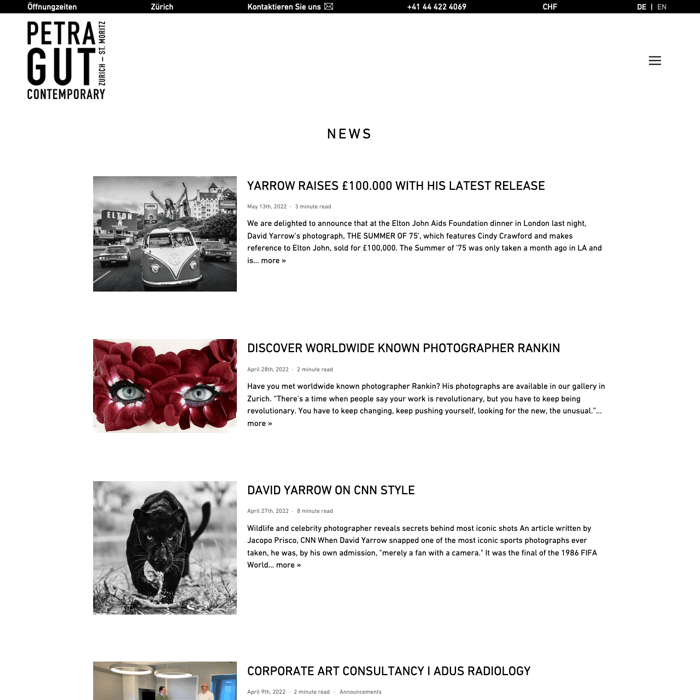
Our Favorite Post: In Honor of F.C. Gundlach and Romy Schneider
Petra Gut Contemporary AG is a Zürich, Switzerland-based contemporary art gallery that exhibits the artworks of both distinguished and newly established artists. They don’t blog in the traditional way, but they use their blogging platform primarily as a news source and art catalog and occasionally publish longer feature pieces about the artists they exhibit in their art gallery.
Petra Gut Contemporary AG write for the public and their visitors, so they try to be as informative and engaging as they can because the main goal of their blog is to provide engaging content for art lovers. The blog posts are well-written and have an editorial quality, always with a couple of prominent images of the artworks that break up the text.
The blog's aesthetic is elegant, sophisticated, and pretty minimalistic, and the way the large blog post previews are aligned gives you the impression that you’re scrolling through a virtual exhibition. Very fitting for an art gallery, indeed.
Key Takeaway: Sometimes, a blog isn’t meant to attract new visitors as much as it’s meant to provide content for the existent readership genuinely interested in your business.
The Sugar Art
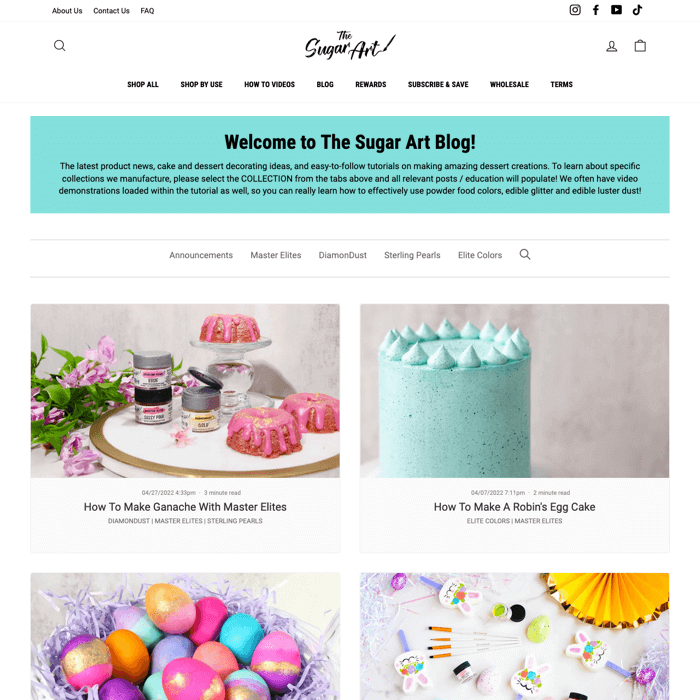
Our Favorite Post: How to Make Edible Paint
Sweets and desserts are always a welcome topic, so let’s talk about The Sugar Art, a family-owned powdered food coloring manufacturer. They make and sell powdered glitter and food colors for decorating cakes and other kinds of desserts.
The Sugar Art is on our list of the best Shopify blog examples because of their consistency and engaging posts. Basically, they stick to only one type of content: their blog is filled with tutorials on decorating all sorts of desserts, but occasionally they include recipes for various cakes and cookies.
Their blog posts are always concise and filled with important information so that the reader is hooked on the content right away. They always include accompanying step-by-step photos of the decorating process in the tutorials and have made use of DropInBlog’s embedding video feature to include tutorial videos from their YouTube channel.
Key Takeaway: Being consistent and concise with your blog content can do wonders. Readers will always know what to expect, and with this, you’ll maintain your image as a reputable and trustworthy brand.
Headphones.com
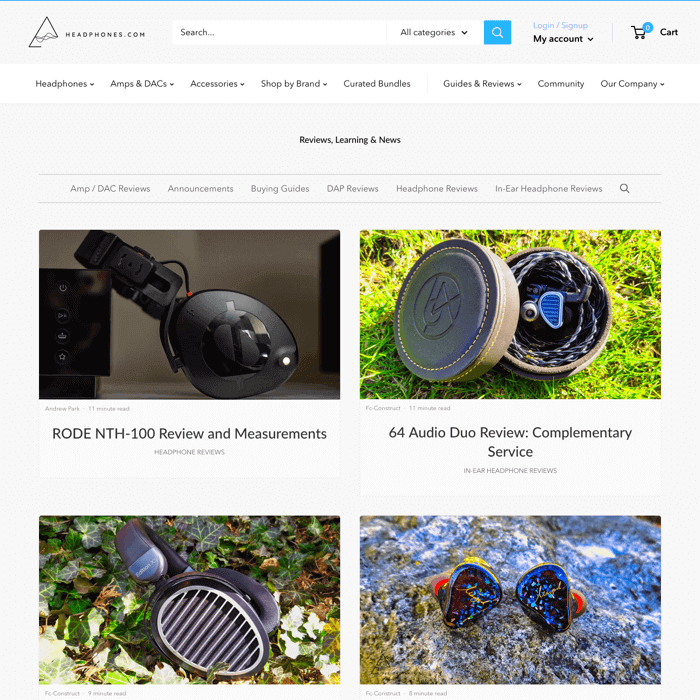
Our Favorite Post: Beginner Hi-Fi: Great Sound Without Breaking the Bank.
As the name implies, Headphones.com is an online store that sells headphones. But not just any kind of headphones – the owners carefully select which models to bring in, so gamers, audiophiles, and sound enthusiasts alike can have a field day.
Headphones.com are well aware that most people interested in sound gear would like to learn more about it, so they’ve made their blog a repository of valuable information. They keep it clean and very professional – most of the blog posts are extensive headphone reviews and some detailed buying guides, but there are also some news-related posts here and there.
The articles are always written in the first person singular, which gives the posts a more personal touch, so it feels like a friend is recommending something to you. You can tell that they know their stuff very well, but the posts are very casually written and engaging.
Key Takeaway: In order to write quality blog posts, you need to really know the topics you write about well. Even if you hire someone else, ensure they understand the niche so they can relay the message in the best way possible.
Sonny Bryan’s Smokehouse

Our Favorite Post: 5 Tips for Successful Holiday BBQ Catering
Sonny Bryan’s Smokehouse is a well-known barbeque restaurant located in Dallas with over a century-long history that includes having several notable historical figures as guests.
As a reader, what will strike you most about their blog is the mouthwatering images of barbeque dishes that permeate their blog. They grab the reader’s attention by posting their own delicacies.
Typically, their blog posts are relatively short, and some even read like a commercial for their restaurant. They’re usually used for promotional purposes about their services during special occasions, like the July 4th BBQ and catering, and they never fail to casually mention the restaurant’s services and leave contact details for customers.
Key Takeaway: If you have a food business and a blog on your site, don’t be afraid to add contact details on each post. Visitors are probably on your blog for a reason, so think of it as making it easier for them to reach you.
Nice N’ CLEAN Wipes
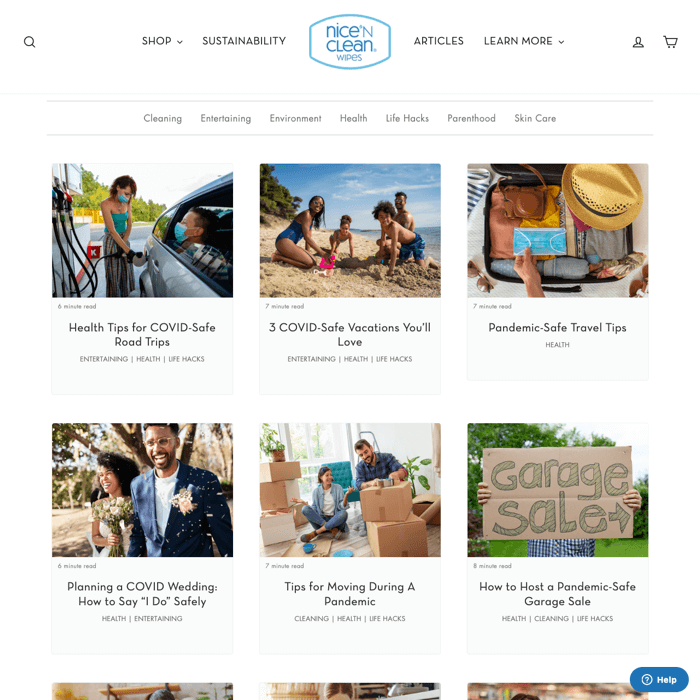
Our Favorite Post: How to Clean and Disinfect Home Gyms
Nice N’ Clean is a brand that sells wipes of all kinds – disinfecting wipes, baby wipes, flushable wipes, and more. It’s a fourth-generation family-owned business that uses mainly sustainable wood sources for the production of their wipes. They even list all the ingredients for their products along with the purpose of each one on an ingredient disclosure page on their website, just so their customers know what they’re getting.
Nice N’ CLEAN have an abundance of content, mostly informational, with topics around sustainability and hygiene being more common.
Their blog posts are always backed with research if the topic requires it, and the research is always referenced in the post itself, which lends their articles more authority.
Key Takeaway: If you’re making health claims, sharing medical information, or covering a sensitive or divisive topic, it’s even more important to lend your article authority by linking to reputable, primary sources of the information you’re sharing as external sources. For example, if you mention any statistics or medical information, try to find the original study or article where the information comes from, rather than linking to the article where you first read it. This is the best way to earn trust from your readers.
BuyWinesOnline.com
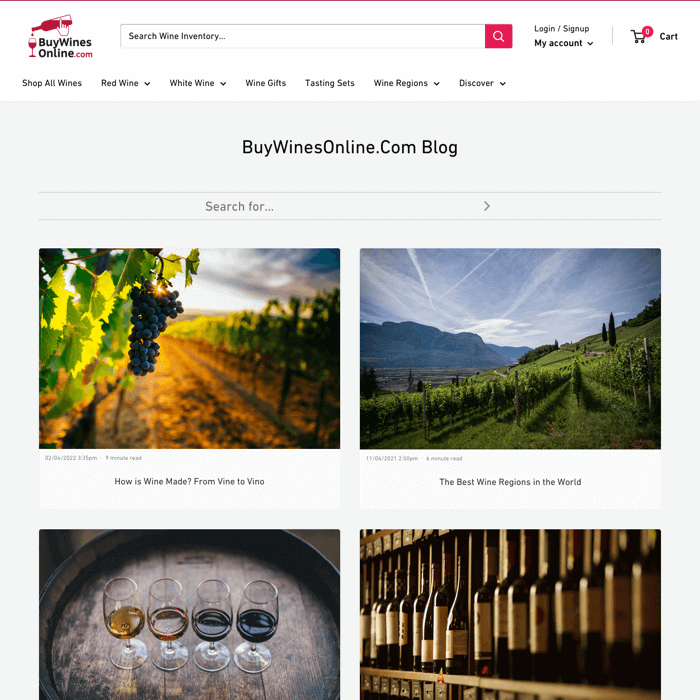
Our Favorite Post: Cooking With Wine: Food & Wine Recipes, Tips & Tricks
As the name suggests, BuyWinesOnline.com is an online shop that sells all kinds of wines from different wine-producing regions. Considering that they have over 800 wines in stock and over 25 years of experience in the wine business, you can tell that they “speak wine” by their blog.
BuyWinesOnline blog about popular wine-related topics that both experienced connoisseurs and inexperienced enthusiasts can enjoy. Posts about how wine is made and the best Cabernet Sauvignon are written beautifully and made to be digested quickly.
They make sure to mention a product in almost every post, but their articles are definitely not salesy. If anything, they put posting interesting information and connecting with their readers first. It’s obvious their blog was made by wine lovers for wine lovers, so anyone reading the blog wouldn’t think twice about trusting the shop.
Key Takeaway: When you’re into your product, it shows, so being genuine while blogging is a very important but often overlooked soft skill.
Step-by-Step Guide to Take Your Content Marketing Strategy Game to the Next Level
Content marketing, aka running a blog, is one of the best marketing strategies to boost traffic and sales. However, it’s not enough to just write any kind of blog posts and hope for the best. Where inexperienced business owners often go wrong is thinking that they can just start publishing blog posts and somehow visitors and customers will come. But it doesn’t work that way.
You need to come up with a content marketing strategy that will get you the results you want, and the first step is conducting thorough keyword research.
This involves analyzing industry keywords, which gives you an insight into what information your target audience wants to learn about your industry. You then apply what you’ve learned and build your content around those keywords.
Let’s break down this process into six steps.
Step 1: Brainstorm relevant seed keywords
Keywords are crucial for SEO because they tell search engines what your content is about.
The first step towards coming up with content for your blog is brainstorming seed keywords related to your business.
Seed keywords are words or short phrases that have high monthly search volumes and high competition. Think of them as the broadest ideas at the heart of a certain niche or industry that come to mind first when you start thinking about it.
Because they’re so broad, you can easily use them as a starting point when you do your keyword research to discover more related keywords and get into the nitty-gritty of your niche.
For example, let’s say you own a natural health supplements store. Some seed keywords related to the supplements niche could be:
Brain health
Joint health
Muscle pain
Muscle growth
Headache relief
Collagen supplements
Omega 3 softgels
Turmeric supplements
Weight loss
Heart health
Vegan supplements
If you find you have a hard time coming up with them, one thing you can do at this stage is research discussions on Reddit and Quora. Virtual spaces like these are great at helping you understand what your target community is interested in.
Just do a simple search of the keywords you came up with and see what people have posted. You’ll notice that some words and phrases repeat here and there, and you’ll begin to see the patterns. Write down all the info that seems relevant because you’ll need it later when you come up with the actual content you’ll be posting.
Step 2: Use a keyword tool to research more related keywords
Once you have your seed keywords, you need to use an advanced keyword tool like Ahrefs (paid) or Semrush (free or paid) to research more keywords related to your content.
Mind you, quality keyword tools can be pricey, for example, Ahrefs, but the data they give you is unbelievable. They’re crucial for building your content strategy, so consider them a worthwhile investment.
If you don’t have the budget for a keyword tool just yet, you can start with a free version of the tool in the beginning, but you’ll be limited to a certain number of searches per day compared to the paid plans. For example, Semrush only gives you ten free search reports per day. Ubersuggest is another free tool that can help to get you started until you’re ready for more advanced features, but you’ll be limited to only three searches per day.
Once you have your list of primary keywords, it’s time to enter them into your keyword tool to obtain more keywords to build your content around.
Here’s an example using Ahrefs:
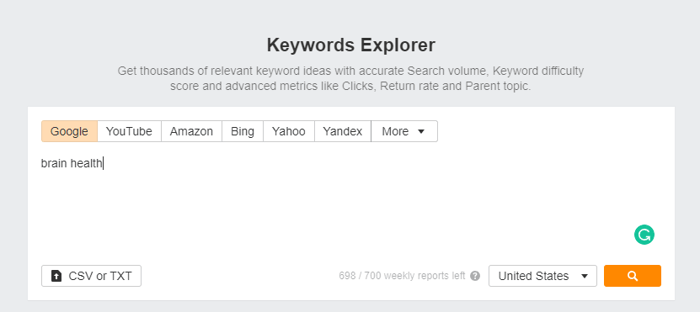
In Ahrefs, you just use the Keywords Explorer tool, located in the bar at the top. It’s really easy and intuitive. You type in the keywords you want to research (you can do one at a time or enter more keywords for bulk search), pick the country you want the data to be relevant to (the US, in our example), and hit search. This is what you’ll get.
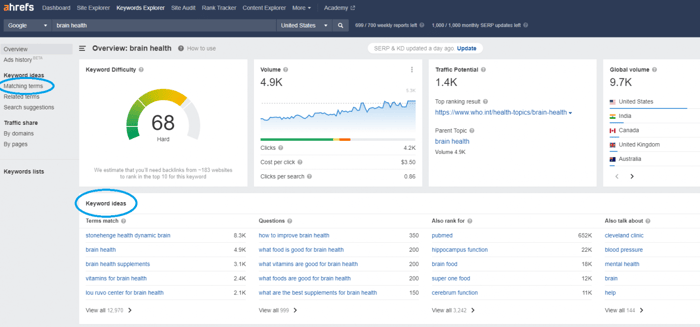
The tool first gives you an overview of the data it has about that keyword. But what you’re most interested in at this stage is the keyword ideas field, particularly the matching terms, where you’re likely to find more seed keywords that can further inform your search, and the question ideas tabs, where Ahrefs lists long-tail keywords related to your phrase.
You can do this exact same thing in Semrush. If you’re using the free version of Semrush, you’ll have to enter each main keyword manually, as it doesn’t allow adding keywords in bulk.
Just enter the keyword in the search bar and navigate to the “Keyword Magic Tool” in the menu on the left. You’ll see different metrics for detailed analytics when you click on it. As you can see on the image, you can filter the results by broad match, phrase match, exact match, and related keywords.
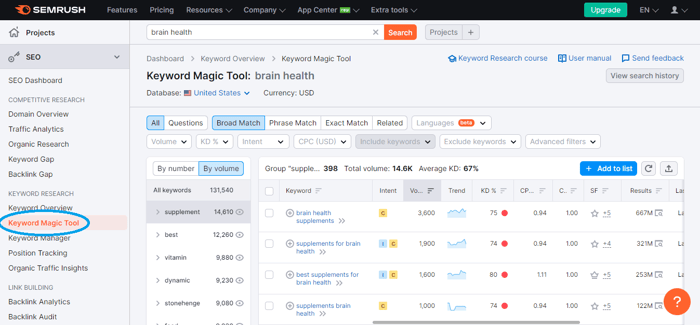
Step 3: Estimate which keywords are worth using
Once you have all your main and related keywords, it’s time to assess which of them are worthwhile content ideas. Here’s what you need to keep in mind.
Keyword competition or difficulty
These two terms describe how hard it is to rank for a specific keyword. They usually depend on how popular a keyword is (based on monthly searches) and how much competition there is in the industry as a whole, along with other factors.
Most keyword research tools will give you data on keyword difficulty based on their own metrics, which can be slightly different, so it’s important to understand how your tool of choice calculates this metric. Here’s a breakdown of how Ahrefs calculates keyword difficulty.
Keyword volume
Keyword volume is the bread and butter of SEO. The term is used to describe how many people are searching for a particular keyword on a search engine every month, on average. It’s probably the metric that you’ll use most frequently when coming up with your content strategy, as your main goal will be to rank for topics people are interested in, and that’s exactly what this metric shows you.
Deciding on the keywords to go after is an informed guessing game
While you obviously want to go after keywords with the highest search volume possible with your content strategy, as that can potentially bring you lots of traffic, it’s not always the wisest idea. The more popular a keyword is, the more competition it has, and the more difficult it is to rank for. Whether you’re able to pull it off will depend on many factors, such as the quality of your content, your website’s authority, and your backlink profile, to name a few.
The main challenge of every keyword strategy is striking the right balance between keywords that have at least a decent volume, relatively low keyword difficulty, and that are relevant to your brand.
If you’re just starting out and your blog is still not established as an authority in your industry, you’ll get the best results if you target keywords with a difficulty of less than 10 and a search volume of 100+. This will give you a list of potential topics that are low-hanging fruits, as SEO experts like to call them, topics that should be relatively easy to rank for if you hit search intent and produce quality content.
Both Ahrefs and Semrush allow you to refine your search with filters for keyword difficulty and search volume.
The filters you’re looking for are KD and Volume in Ahrefs.

And Vol. and KD in Semrush.
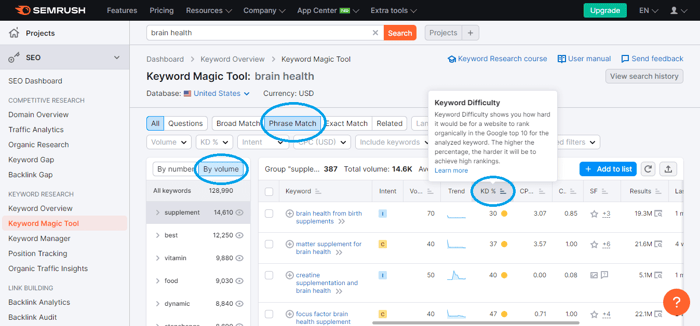
Finding your way around SEO
This is just the tip of the iceberg that is SEO. To continue to refine your content strategy, we encourage you to learn more about SEO.
Here are some excellent resources that can get you started:
What is Search Intent? A Complete Guide for Beginners, by Ahrefs
A Beginner's Guide to Keyword Search Volume, by Semrush
Keyword Research: The Beginner's Guide, by Ahrefs
The Insanely Simple SEO Strategy for 2022 (The Orchard Strategy), by Ahrefs
Keyword Difficulty: What Is It and Why Is It Important? by Semrush
Step 4: Learn to distinguish between relevant and irrelevant keywords
As you do your research, you will inevitably stumble upon a myriad of related keywords, some of which may confuse you or make you think they’re relevant just because they showed up on the keyword tool.
The trick here is to use common sense and really think about the visitor’s intent behind the search. For example, for “brain health,” you might see some keywords that are more related to mental health, which isn’t exactly unrelated, but it’s not really what someone interested in natural supplements would be looking for. On the other hand, “brain health supplements” and “best supplements for brain health” just make sense, and they can lead someone to your blog.
Lastly, if you see some weird-sounding keywords that don't seem to be related to your niche in any way, just skip them. Trying to incorporate them into your content just because your keyword tool listed them is not worth it.
Step 5: Come up with blog topics
Now that you have selected all the relevant low-competition, good-volume keywords, it’s time to come up with some blog topics. You can start by writing down the first few topics that come to mind. For example:
10 Best Supplements for Brain Health
How to Improve Your Brain Health
5 Bad Habits That Impact Your Brain Health
Omega 3 for Brain Health
The Benefits of Exercising for Brain Health
Once you get your own ideas down on paper, it’s time to get inspired. Type in your keywords in Google search. The top 10 pieces of content ranking for your target keyword can inform what you decide to write. Ask yourself the following questions:
Are these pieces hitting search intent?
Can I use some of them as inspiration?
Are there things they don’t cover that I can?
Is there another topic idea that might help me target this keyword better?
Next, look at the “People also ask” section that usually shows up just below the first search result. You’ll notice that Google gives you a variety of questions related to the topic. These are long-tail keywords that you can target in separate articles or use to flesh out your initial article idea. The potential for inspiration here is unlimited – the more times you click on them, the more ideas Google loads.
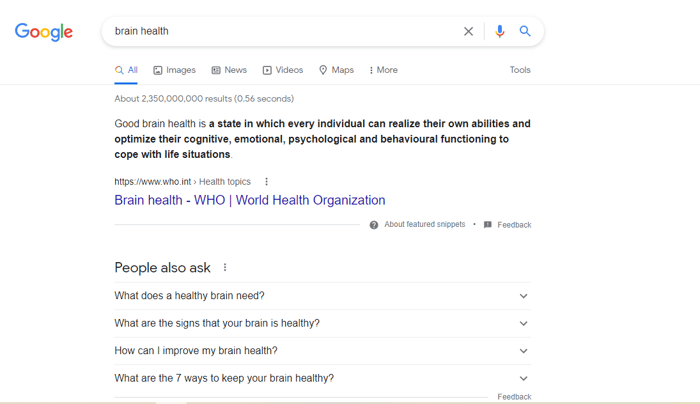
It’s also useful to check out the “Related searches” section at the bottom of the SERPs.
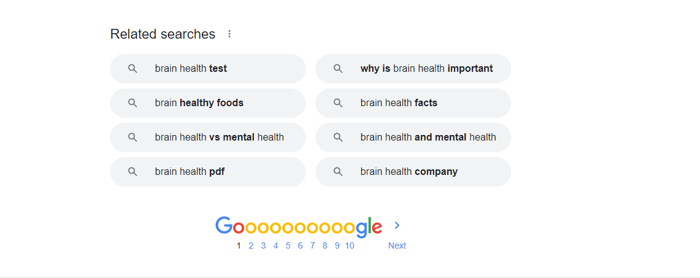
And now that the most significant chunk of the job is done, all that’s left is to actually write the blog posts yourself or have them written by a professional content writer.
If you’re not that skilled of a writer, or you think it would be much more useful for you to focus on other areas of your business, you can hire professionals to do it for you. There are different platforms, like Upwork, Fiverr, WriterAccess, and others, where you can connect with experienced professionals that will help you realize your content strategy.
Step 6: Obtain backlinks
Lastly, ranking on the first or even second page of search results isn’t an easy feat. Just having a keyword and content strategy is by no means enough.
For your blog to perform well, you need backlinks. Backlinks are links from a page on another website that link back to your page. The goal is to have as many different websites link back to your website as possible, and the more authoritative they are, the better. In the world of search engine algorithms, this strengthens your backlink profile, resulting in better domain authority, indicating that your site is trustworthy and relevant, and increasing your chances of ranking.
As you grow your blog, you can make link building a bigger priority. For now, we want to share some beginner-friendly tips to help you get started:
Share your posts on social media to increase exposure. It’s not only an excellent way to promote your blog and your store, but it also increases the chances that your posts will be shared, reposted, and linked to.
Do a bit of networking. Reach out to other bloggers and ask them if they’re interested in guest posting on each other’s blogs. In this way, you’ll each add backlinks to your respective sites.
Reach out to people or blogs you’ve mentioned in your posts. Chances are, they’ll link to your article and share it on social media.
Find broken links on other websites and offer to fix them. This is a more advanced way of getting backlinks, but it can be very effective. Basically, you need to use a tool to find broken backlinks on sites within your niche, contact the owner, and offer to replace the links with your own relevant content. Most keyword tools have the option to search for broken backlinks (including Ahrefs and Semrush).
Use the skyscraper technique. This technique involves finding high-ranking content, creating a better version of it, and promoting it, i.e., becoming a taller skyscraper than the tallest skyscraper. To do this, you need to pay attention to each detail of the high-ranking content, including the article length, images used, quality of writing, and the actual topic, and make your version of the article unbeatable.
If you’re just starting out, it can be challenging, but don’t get disheartened. Yes, the competition is tough nowadays, but if you play your cards right and use a variety of SEO techniques, your work will pay off, and you’ll start seeing results.
FAQs on Running a Shopify Blog
How do I start a Shopify blog?
Starting a Shopify blog has never been easier with DropInBlog. It’s easy to set it up, and once you’re done, you can start blogging right away! Here’s what you need to do:
1. Install the DropInBlog app, which you can find in the Shopify store.
2. Now you’re ready for blogging! Just write your first blog post as you normally would and add images or embed YouTube or Vimeo videos if necessary.
3. Once you do that, it’s time to optimize your blog post for search engines by using the built-in SEO analyzer that will tell you exactly how to do it.
4. You’re all set! You can now publish your post and admire your work.
Is blogging on Shopify good for SEO?
Blogging on Shopify is great for SEO, particularly if you use DropInBlog’s built-in SEO analyzer. This tool allows you to optimize the article for the primary keyword and optional secondary keywords and add the page title and meta-description.
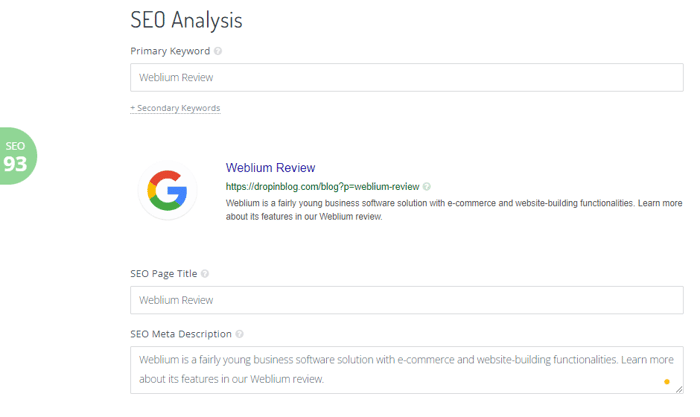
The SEO analyzer is an interactive tool. It scores your content and gives you feedback in the form of a grading system. Your content is graded in three sections: Page Title, Meta-Description, and Content, and you get a score for each that adds up to the total score. The higher the score is, the better optimized your article is.

The best thing about the SEO analyzer is that it has “checklists'' for each of the sections. It shows you detailed information about how your article is doing and tells you exactly what you need to improve to make your score higher.
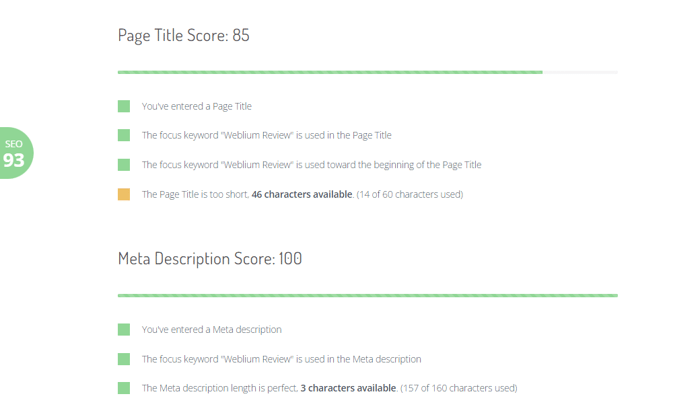
How can you monetize a Shopify blog?
You can monetize your Shopify blog in many different ways, like by adding affiliate links and ads or writing sponsored content. But beyond that, you can also embed your products into your blog posts, which makes it possible for your customers to buy them right away.
With DropInBlog, embedding your products into your blog posts is quick and easy. All you need to do is access the DropInBlog app through your Shopify account, choose the post where you want to add a product, click on “Add Shopify Product” in the navigation bar, and follow the instructions on the screen. For a better illustration of the process, you can check out this video.
Do blog posts work on Shopify stores?
Of course! After installing the DropInBlog blogging app, you’ll be able to create blog posts on any Shopify store.
Which Shopify theme is best for blogging?
Shopify offers eight free e-commerce themes for your store, each suited for a different type of business, but there is also a good selection of paid themes if you want something else.
That being said, your blog layout is independent of your store theme. One of the main characteristics of DropInBlog is that it adapts to whatever Shopify theme you have chosen because it inherits your CSS, so any theme you’re using will be perfect for blogging!
How do blogs work on Shopify?
Blogging on Shopify is a straightforward and easy process. You start by installing a blogging app, then doing keyword research related to the content you want to write, and following the other steps we outlined above.
Once you have your keywords and search volume information, you can start your content marketing by writing engaging posts and optimizing them for search engines with the SEO analyzer.
Can I put recent blog posts on my Shopify homepage?
Yes. Adding your recent blog posts to your Shopify homepage is the best way to increase engagement. It grabs the visitors’ attention, keeps them longer on the site, and helps drive more traffic to your blog. To learn how to put recent posts to your Shopify blog, check out this video.
Does it cost money to start a blog?
Running a Shopify blog is fairly easy and writing articles is free if you do it yourself, which is probably the best option in the beginning. However, if you’re really serious about content marketing, it’s likely that you’ll need to hire writers and potentially subscribe to a keyword research tool, which can be an investment. As your business grows, you’ll need to work with trained professionals who can take your content to the next level while you’re busy with admin stuff.
Moreover, there’s a small cost involved in using an advanced blogging app, but when you think about it, this cost is minimal compared to the value of the traffic you can drive with blogging. You can think of it as a minimal investment with a major payoff.
Is Shopify a good place to start a blog?
Shopify is a great place to start a blog. It’s been the largest all-in-one e-commerce platform for years, so it’s no wonder most businesses, big or small, choose to set up their stores on the platform.
Using the platform for blogging can help your e-commerce brand in various ways.
First of all, it helps you build rapport with your customers. Communication is vital for converting visitors to customers and one-time customers to returning customers. In this way, you establish credibility and instill trust in your customers.
Moreover, blogging gives you a platform to educate your customers about your products, your niche, or anything else you may want to share. Blogging is flexible like that. You can use your platform to share news and updates about the store and even write personal posts if that’s something you’d like to do.
And last and most important: from a business point of view, blogging is the best way to drive traffic to your store and promote your products. By doing this, you’ll be driving more sales and making more money.
So, the formula is simple: communicate with your visitors by writing engaging posts and promoting your products, and enjoy your continuous success!
Over and Out
Blogging is a flexible and effective marketing strategy for communicating with customers and building a customer base, promoting your products, and driving traffic to your store, which inevitably leads to higher profits. As you can see from our the best Shopify blog examples, each business, whether big or small, interprets blogging in its own unique way, which is why there is something to be learned from each of them.
However, one thing is certain – a good content strategy cannot exist without a keyword strategy and keyword optimization. You need two tools to achieve that – a keyword research tool, to give you the data you need to make informed decisions, and an SEO analyzer such as the one in our advanced blogging app, to help you optimize your content right before it goes live.
If you’ve ticked off both from your list, all that remains for you is to take the plunge and start blogging!
